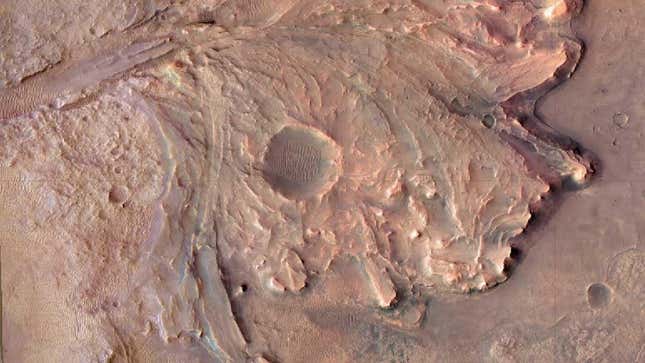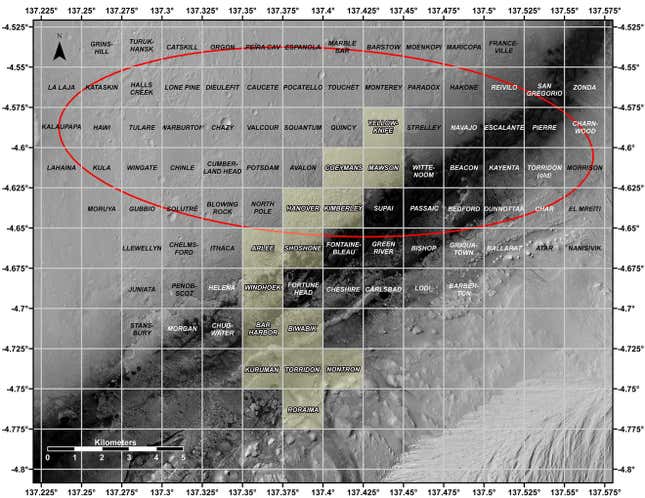
On February 18, 2021, a car-sized robot parachuted its way down to the surface of Mars to begin searching for signs of ancient life on the Red Planet. From that day on, the landing site where NASA’s Perseverance rover plopped down became known as Octavia E. Butler, named after the prolific science fiction author behind many famous titles such as Parable of the Sower.
Ever since NASA began sending rovers to Mars, the space agency has had a tradition of naming features of the Martian terrain. Those names have varied from Indiana Jones, Barnacle Bill, and Scooby-Doo to more formal ones such as Jezero Crater, named after a town in Bosnia and the Slavic word for “lake,” and Endurance, after the ship that carried Ernest Shackleton’s expedition to Antarctica. As it turns out, there’s a method behind the space agency’s naming madness.
NASA has thousands of names for craters and hills on Mars, as well as every boulder, pebble, and rock surface that the rovers come across. “The No. 1 reason we pick all these names is to help the team keep track of what they’re finding each day,” Ashwin Vasavada, the Curiosity mission’s project scientist at NASA’s Jet Propulsion Laboratory, said in a statement. “Later on, we can refer to the many hills and rocks by name as we discuss them and eventually document our discoveries.”

More than 2,000 of those names have been approved by the International Astronomical Union (the famously unpopular body of scientists responsible for downgrading Pluto to a dwarf planet), and are therefore considered official. Those official names also follow a set of rules put forth by IAU, stating, for example, that craters larger than 37 miles (60 kilometers) are named after famous scientists or science-fiction authors while smaller craters are named after towns with populations of less than 100,000 people, according to NASA. Belva, an impact crater within Jezero, which the Perseverance rover is currently exploring, is named after a West Virginia town.
Beyond the official names, NASA scientists get creative with unofficial nicknames of smaller features that they encounter on Mars. The team behind NASA’s InSight mission nicknamed a rock as “Rolling Stones Rock” after it got tossed around from the lander’s touchdown on Mars.
The nicknames aren’t always meant to be humorous, the Curiosity rover team named a Martian hill after their colleague Rafael Navarro-González, who died from covid-19 complications.
Mission teams also sometimes pick a theme for sites on Mars, compiling hundreds of nicknames related to that theme. The Curiosity rover is currently exploring a sulfate-enriched region of Mars, which is reminiscent of the Pacaraima Mountains, located near the border of Venezuela, Brazil, and Guyana. As a result, the rover team chose the first South American quadrant theme for that region. Meanwhile, the Perseverance rover team picked national park themes, selecting names such as the Rocky Mountain quadrant, which includes a Powell Peak rock surface area.
Earlier missions adopted a more casual naming process, with random names like Cabbage Patch, Pop Tart and Yogi Rock being used for the Sojourner rover mission (which landed on Mars in 1997). Sure, having a system in place is nice, but you would never forget where you last saw the Yogi Rock on Mars.
For more spaceflight in your life, follow us on Twitter and bookmark Gizmodo’s dedicated Spaceflight page.
Science - Latest - Google News
June 10, 2023 at 04:20AM
https://ift.tt/vrt8zLK
Casper, Scooby-Doo and Yogi Rock: How NASA's Naming System for Martian Landscape Evolved Over Time - Gizmodo
Science - Latest - Google News
https://ift.tt/s2iQ4wC
https://ift.tt/UmZXgrI
Bagikan Berita Ini

















0 Response to "Casper, Scooby-Doo and Yogi Rock: How NASA's Naming System for Martian Landscape Evolved Over Time - Gizmodo"
Post a Comment